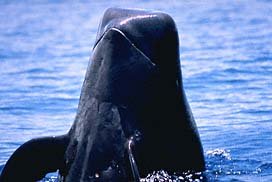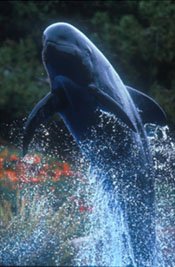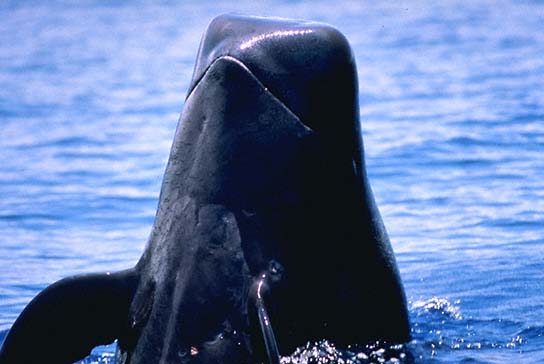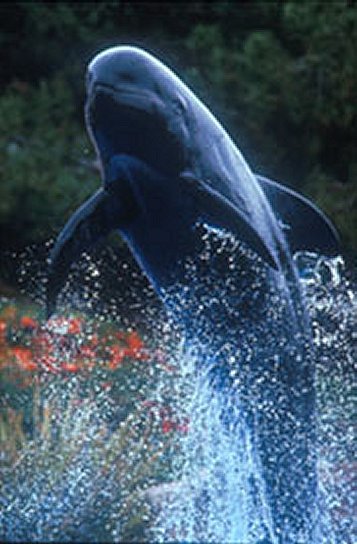Marine Mammals
Description
To 23' (7 m). Robust; black overall, anchor-shaped gray patch on chin, gray area on belly, sometimes light chevrons extend posteriorly from each side of blowhole, gray saddle sometimes behind dorsal fin. Head thick, bulbous, sometimes flattened or squarish in front, especially in older males. Flippers relatively short, one-sixth body length. Dorsal fin falcate, low, with long base, far forward on back.
Discussion
The Short-finned Pilot Whale is also called the Blackfish, Pothead, Pilot Whale, and Shortfin Pilot Whale. Off California, the scientific name G. scammoni is sometimes applied. These whales often occur in very large herds and are frequently stranded in masses. In the Lesser Antilles they are killed for both oil and meat, and hunted with harpoons from open boats. They feed on squids and fishes. Short-finned Pilot Whales have been reported to "spy-hop," or "pitchpole" (hang vertically in the water with their head out), but they rarely breach. They do not ride bow waves of boats. When resting on the surface, individuals often position themselves side by side in long lines. Their habit of slapping their flukes on the surface is called lobtailing.
Tragedy at Blackfish Creek On July 29, 2002, a pod of 55 pilot whales swimming in Cape Cod Bay stranded themselves on a Cape beach. Rescuers descended and managed to save 46 of the whales, cheering happily as they swam back out to open sea. A day later, however, the rescued whales returned, beaching themselves again, 25 miles eastward. In the end, the entire pod died.
Nobody knows why pilot whales routinely strand on beaches. One theory is that they are sick, or one member is sick and the other members of the tightly cohesive pod follow it ashore. They may become confused by currents and strand accidentally when the tides go out on the vast, shallow tidal flats of Cape Cod Bay. A local theory places the blame on a change to the landscape caused by the Cape's constant shifting of sands. Thousands of years ago Blackfish Creek, now a small creek running into a salt marsh near where the bulk of the recent pod finally died, was an open waterway slicing through the arm of the Cape and connecting the bay to the open ocean to the south. Is it possible that an evolutionary memory sends the whales there with the information that they can take a shortcut to the ocean? Nobody knows, but it is a question Cape Codders have asked for years, most notably when 1,500 pilot whales stranded and died at Blackfish Creek in 1884. In fact, "blackfish" is another name for the pilot whale, and this location got its name from the frequency of strandings here.




